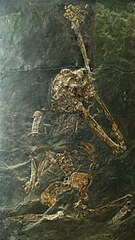 |
| Reconstruction of O. bamboli (Pavel Major / ICP) |
Oreopithecus bamboli was primate species, surely a hominine (great ape excluding orangutans) that lived in Tuscany and Sardinia some 8.2-6.7 million years ago.
It has great interest regarding human evolution because it is the oldest known ape to have developed a pad-to-pad precision grip, a characteristic otherwise only found in the human genus.
This trait, hotly debated in the last decades, has been recently confirmed by researchers of the Catalan Institute of Paleontology Miquel Crusafont (ICP). It must be said however that this development is considered convergent evolution and not ancestral to our own precision grip.
 |
| O. bamboli fossil (CC by Ghedoghedo) |
I guess that much of the controversy is caused by the old hypothesis that argued that it was the precision grip itself which elicited human brain development, something that obviously did not happen with Oreopithecus.
Other traits of this species are quite different from our own or our australopithecine relatives. They probably walked upright but with different gait (unlike the more human-like Sahelanthropus, of similar age) and their feet were very much unlike ours, with a very open angle for the big toe (hallux).
It seems that their environment was swampy and not strictly forestal.
Ref.: Sergio Almécija et al., The morphology of Oreopithecus bambolii pollical distal phalanx. AJPA 2014. Pay per view → LINK [doi:10.1002/ajpa.22458]
Thanks for this interesting paper, which says that Oreop displays a human-like medio-laterally wide tuft & thumb-to-hand length ratio, compatible with pad-to-pad precision grasping & enhanced manipulative skills.
ReplyDeleteCommon sense says that narrower instruments are better for fine manipulations, but anthropocentric paleo-anthropologists often assume that broad tufts indicate a precision grip: "humans have broad tufts, humans have precision grip, therefore broad tufts indicate precision grip". They illogically reason A->B & A->C, hence B->C (but logica is A->B & B->C, hence A->C).
But broadening of the end-phalanges are typically seen in (all?) swimming animals. Oreop lived in swamp forests. We know archaic Homo swam a lot (Pleistocene diaspora along coasts & rivers, google "econiche Homo" & "Laden Verhaegen"). Could Oreop also have swum regularly (parallelism)? It would also explain the "human-like thumb-to-hand length ratio". OTOH, Oreop's widely divergent big toe suggests arborealism, and "a long tendon of a flexor muscle" in its thumb might suggest frequent vertical climbing & perhaps arm-hanging. Swimming, possibly wading or floating vertically, vertical climbing in the branches above the swamp - all this suggests Oreop spent a lot of time in water, possibly frequently feeding on floating vegetation (google "aquarboreal").
Oreop apparently used its hands for swimming & climbing & food collection. Not unexpected for a primate in swamp forests...
I don't know (have no access to the paper) if the conclusion is reached as you say by assuming that "broad tufts indicate precision grip" or rather not. Considering that this issue has been debated form more than two decades and that there are several full skeletons of Oreopithcus, I would find it naive that they would say just that. The precision grip is granted, I understand, not by "broad tufts" but by long opposable thumbs and, from what I understood from all the articles, that's what they are saying. Am I wrong?
Delete"We know archaic Homo swam a lot"...
I wouldn't put my money on it. African rivers are full of dangerous animals (particularly crocodiles) and even today many Africans can't swim, even if they live by rivers and travel through them regularly. It's better to stay on the canoe if possible, you know. Most apes and monkeys are quite phobic to rivers anyhow (for example it is a large river what protects the existence of bonobos vs. their more violent chimpanzee cousins and it's almost certain that neither species ever crossed it at all in almost two million years, i.e. since the formation of the Congo basin).
Said that, it's possible that Oreopithecus did swim or at least waded deep in the water (no crocs in Europe). I have pondered myself that their very open hallux angle could have helped them to stand on the mud in fact, just the same that many animals have wider or extensible feet to stand on snow. But I doubt they lived all the time in the water, that's most un-apeish, and retired to trees for rest, as chimps and bonobos do.